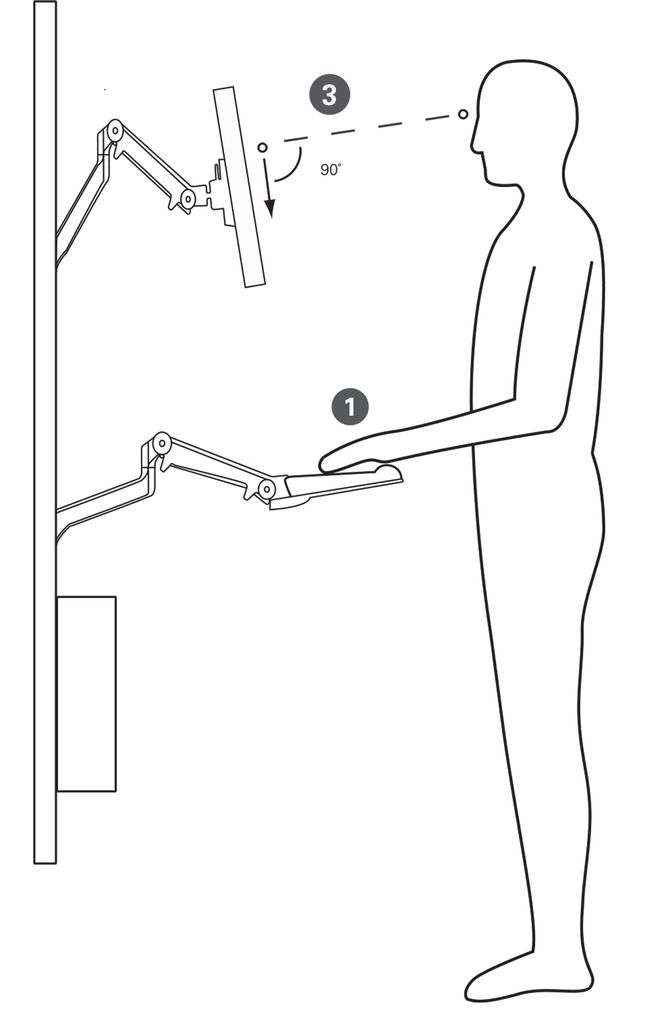10 Ergonomics Dos and Don’ts For Those Now Working from Home
10 Ergonomics Dos and Don’ts for Those Now Working from Home
Tips for making sure you stay safe and comfortable in your temporary workspaces
In an effort to stem the number of coronavirus infections, millions of Americans are now working from home, transforming kitchen tables and bedrooms into temporary home offices. Many are working under less-than-ideal ergonomic conditions—a kitchen chair that’s too low, a table that’s too high. You get the idea. Poor ergonomics can make or break your work-from-home experience.
With that in mind, BU Today reached out to Carolyn Herkenham, a Boston University Environmental Health & Safety senior specialist and industrial hygienist, and licensed physical therapist Kelly Pesanelli (CGS’94, Sargent’96,’98), a Sargent College of Health & Rehabilitation Sciences lecturer in health sciences, for some tips and tricks to help you create an ergonomic workstation at home.
DON’T hunch over your laptop

It’s easy to work on your laptop for a few hours on the weekend, but doing so for 40-plus hours a week can lead to back, shoulder, and neck strain. If you can, use an external monitor or laptop stand (with an external keyboard and mouse) to prop up your screen. When looking at the screen, your eye line should be level with the address bar on your web browser.
DO work at an appropriate height
Find a working height so that your elbows naturally fall flush with your table/desk height. This will promote better wrist alignment rather than impingement or carpal tunnel stress.
DO use an office chair if possible
Adjustable features on an office task chair will save you from lumbar and neck discomfort.

DON’T give up on your current chair
If you don’t have the option of an office chair, there are some household items you can use to help you adjust. Putting a firm cushion or tightly folded towel under your buttocks will raise your hips and increase the curve of your spine, making sitting more comfortable.
DON’T let your feet dangle
Place your feet on a few books or boxes under your desk, so that your thighs are nearly parallel to the floor and your hips are slightly higher than your knees. This will reduce stress on your lumbar spine.
DO follow the 20/20/20 rule
For every 20 minutes spent looking at a computer screen, you should spend 20 seconds looking at something else 20 feet away. This gives your eye muscles a break and helps reduce eye strain.

DON’T turn your couch into a workstation
As tempting as it is, the couch is not an optimal place to work at your computer for the entire day. Although it may be comfortable, having your legs or full body in a vertical position can lead to muscle numbness and discomfort.
DO customize a space to fit you
Try to set up a workstation that you can make entirely your own. Sharing a workstation means you need to adjust your computer height, chair, and furniture every time you sit down. Often, you may choose to skip adjusting the workstation altogether. If you are the only person using the space, customizing will reduce the time and discomfort of sitting at a station that does not fit you.
DON’T skip lunch and make sure you stay hydrated
It’s easy to snack throughout the day instead of eating like you did in the office. Making a meal and staying hydrated gives you the opportunity to stand up, walk around, and let your eyes have a rest from the computer screen.
DO make sure you get up and walk around
The goal is to get in as many steps as possible during the day, even if you are at home instead of on campus.
If you are interested in speaking to a BU Environmental Health & Safety professional, you can fill out an ergonomics self-assessment here.
Carolyn Herkenham can be reached at cherkenh@bu.edu. Kelly Pesanelli can be reached at kpesan@bu.edu.
Comments & Discussion
Boston University moderates comments to facilitate an informed, substantive, civil conversation. Abusive, profane, self-promotional, misleading, incoherent or off-topic comments will be rejected. Moderators are staffed during regular business hours (EST) and can only accept comments written in English. Statistics or facts must include a citation or a link to the citation.